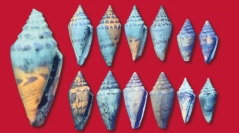

 Geodiversitas
43 (24) - Pages 1309-1339
Geodiversitas
43 (24) - Pages 1309-1339Conidae is a diverse family of carnivorous marine gastropods. They rapidly diversified during the Miocene and now they inhabit tropical and subtropical seas. Here we attempt to provide the first inventory of fossil conids from the late Miocene of Crete (Greece). This paper deals with the genera Conilithes and Conus (Kalloconus) da Motta, 1991 and will be followed by papers presenting other genera of the family. Using UV light, we described the residual colour patterns of eleven species, of which three are new: Conilithes herodus n. sp., Conus (Kalloconus) helladicus n. sp and Conus (Kalloconus) asterousiaensis n. sp. One species is in open nomenclature: Conilithes sp.. Six species are first recorded in the late Miocene of Crete: Conilithes brezinae (Hoernes & Auinger, 1879), Conilithes striatulus (Brocchi, 1814), Conus (Kalloconus) neumayri Hoernes & Auinger, 1879, Conus (Kalloconus) hendricksi (Harzhauser & Landau, 2016), Conus (Kalloconus) gulemani Erünal-Erentöz, 1958 and Conus (Kalloconus) letkesensis (Harzhauser & Landau 2016). Conilithes antidiluvianus (Bruguière, 1792) is the only species already recorded by past Greek authors. Firstly, our study reveals that only two species are restricted to the late Miocene of Crete (Conilithes herodus n. sp. and Conus (Kalloconus) helladicus n. sp.). Secondly, we found deep relationships with the conid assemblage from the Langhian of Paratethys (six shared species). This result could be interpreted as a conid fauna, present and widely distributed since the Langhian-Serravallian in both the Paratethys and the eastern Proto-Mediterranean. This fauna disappeared from Paratethys during the Serravallian, but probably persisted in the eastern Proto-Mediterranean, as suggested by the relationships with the Serravallian of Turkey and the Tortonian of Crete (this work). On the other hand, the weak relationships with the late Neogene of Italy might be biased because, for the comparison with Italian faunas, we used works that illustrated Conidae without UV light.
Conidae, late Miocene, Greece, Crete Island, ultraviolet light, new species